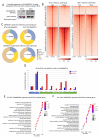Global Chromatin Changes Resulting from Single-Gene Inactivation-The Role of SMARCB1 in Malignant Rhabdoid Tumor
- PMID: 34071089
- PMCID: PMC8197137
- DOI: 10.3390/cancers13112561
Global Chromatin Changes Resulting from Single-Gene Inactivation-The Role of SMARCB1 in Malignant Rhabdoid Tumor
Abstract
Human cancer typically results from the stochastic accumulation of multiple oncogene-activating and tumor-suppressor gene-inactivating mutations. However, this process takes time and especially in the context of certain pediatric cancer, fewer but more 'impactful' mutations may in short order produce the full-blown cancer phenotype. This is well exemplified by the highly aggressive malignant rhabdoid tumor (MRT), where the only gene classically showing recurrent inactivation is SMARCB1, a subunit member of the BAF chromatin-remodeling complex. This is true of all three presentations of MRT including MRT of kidney (MRTK), MRT of the central nervous system (atypical teratoid rhabdoid tumor-ATRT) and extracranial, extrarenal rhabdoid tumor (EERT). Our reverse modeling of rhabdoid tumors with isogenic cell lines, either induced or not induced, to express SMARCB1 showed widespread differential chromatin remodeling indicative of altered BAF complex activity with ensuant histone modifications when tested by chromatin immunoprecipitation followed by sequencing (ChIP-seq). The changes due to reintroduction of SMARCB1 were preponderantly at typical enhancers with tandem BAF complex occupancy at these sites and related gene activation, as substantiated also by transcriptomic data. Indeed, for both MRTK and ATRT cells, there is evidence of an overlap between SMARCB1-dependent enhancer activation and tissue-specific lineage-determining genes. These genes are inactive in the tumor state, conceivably arresting the cells in a primitive/undifferentiated state. This epigenetic dysregulation from inactivation of a chromatin-remodeling complex subunit contributes to an improved understanding of the complex pathophysiological basis of MRT, one of the most lethal and aggressive human cancers.
Keywords: BAF; PBAF; SMARCB1; SWI/SNF; chromatin remodeling; lineage differentiation; ncBAF; rhabdoid tumors; tissue differentiation.
Conflict of interest statement
The authors declare no conflict of interest.
Figures





Similar articles
-
Functional relevance of genes predicted to be affected by epigenetic alterations in atypical teratoid/rhabdoid tumors.J Neurooncol. 2019 Jan;141(1):43-55. doi: 10.1007/s11060-018-03018-6. Epub 2018 Nov 16. J Neurooncol. 2019. PMID: 30446899
-
SMARCB1-deficient Tumors of Childhood: A Practical Guide.Pediatr Dev Pathol. 2018 Jan-Feb;21(1):6-28. doi: 10.1177/1093526617749671. Epub 2017 Dec 27. Pediatr Dev Pathol. 2018. PMID: 29280680 Review.
-
Phosphoproteomic analysis reveals Smarcb1 dependent EGFR signaling in Malignant Rhabdoid tumor cells.Mol Cancer. 2015 Sep 15;14:167. doi: 10.1186/s12943-015-0439-5. Mol Cancer. 2015. PMID: 26370283 Free PMC article.
-
SMARCB1-mediated SWI/SNF complex function is essential for enhancer regulation.Nat Genet. 2017 Feb;49(2):289-295. doi: 10.1038/ng.3746. Epub 2016 Dec 12. Nat Genet. 2017. PMID: 27941797 Free PMC article.
-
SMARCB1-Deficient Cancers: Novel Molecular Insights and Therapeutic Vulnerabilities.Cancers (Basel). 2022 Jul 27;14(15):3645. doi: 10.3390/cancers14153645. Cancers (Basel). 2022. PMID: 35892904 Free PMC article. Review.
Cited by
-
Patterns of transcription factor binding and epigenome at promoters allow interpretable predictability of multiple functions of non-coding and coding genes.Comput Struct Biotechnol J. 2023 Jul 14;21:3590-3603. doi: 10.1016/j.csbj.2023.07.014. eCollection 2023. Comput Struct Biotechnol J. 2023. PMID: 37520281 Free PMC article.
-
A comprehensive analysis of minimally differentially methylated regions common to pediatric and adult solid tumors.NPJ Precis Oncol. 2024 Jun 1;8(1):125. doi: 10.1038/s41698-024-00590-1. NPJ Precis Oncol. 2024. PMID: 38824198 Free PMC article.
-
Epigenetic and pharmacological control of pigmentation via Bromodomain Protein 9 (BRD9).Pigment Cell Melanoma Res. 2023 Jan;36(1):19-32. doi: 10.1111/pcmr.13068. Epub 2022 Oct 3. Pigment Cell Melanoma Res. 2023. PMID: 36112085 Free PMC article.
-
SMARCB1 Deficiency as a Driver of the Hallmarks of Cancer in Rhabdoid Tumours: Novel Insights into Dysregulated Energy Metabolism, Emerging Targets, and Ongoing Clinical Trials.Metabolites. 2025 May 3;15(5):304. doi: 10.3390/metabo15050304. Metabolites. 2025. PMID: 40422882 Free PMC article. Review.
-
Beyond SMARCB1 Loss: Recent Insights into the Pathobiology of Epithelioid Sarcoma.Cells. 2022 Aug 24;11(17):2626. doi: 10.3390/cells11172626. Cells. 2022. PMID: 36078034 Free PMC article. Review.
References
-
- Biegel J.A., Zhou J.Y., Rorke L.B., Stenstrom C., Wainwright L.M., Fogelgren B. Germ-line and acquired mutations of INI1 in atyp-ical teratoid and rhabdoid tumors. Cancer Res. 1999;59:74–79. - PubMed
-
- Hasselblatt M., Gesk S., Oyen F., Rossi S., Viscardi E., Giangaspero F., Giannini C., Judkins A.R., Frühwald M.C., Obser T., et al. Nonsense Mutation and Inactivation of SMARCA4 (BRG1) in an Atypical Teratoid/Rhabdoid Tumor Showing Retained SMARCB1 (INI1) Expression. Am. J. Surg. Pathol. 2011;35:933–935. doi: 10.1097/PAS.0b013e3182196a39. - DOI - PubMed
Grants and funding
LinkOut - more resources
Full Text Sources
Molecular Biology Databases

